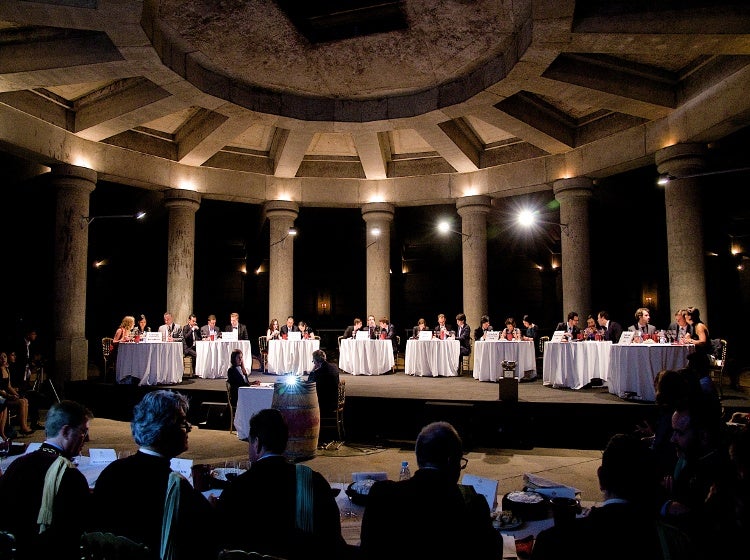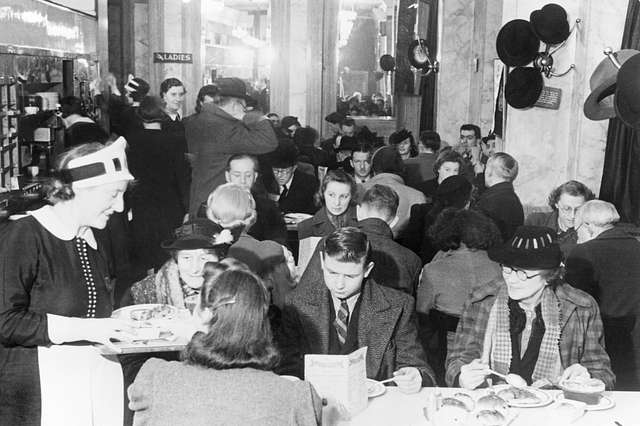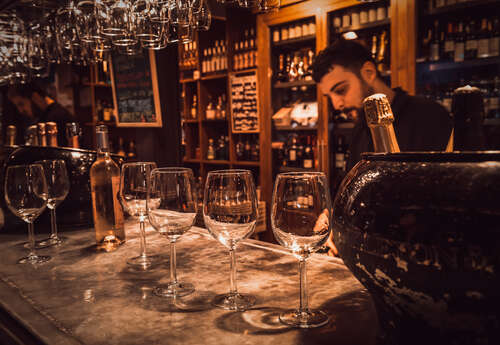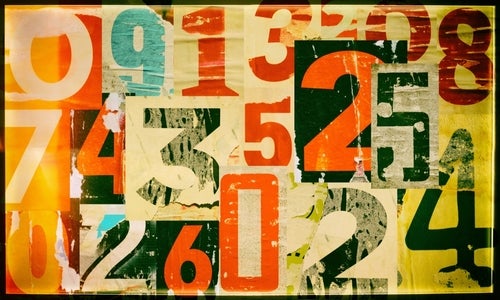
On June 14, 2013, guests at Château Lafite Rothschild trailed down candlelit stone steps into the château’s chilly circular cellar to watch eight university wine teams battle for the Left Bank Bordeaux Cup. This was the 12th staging of the annual competition organized by the Commanderie du Bontemps de Médoc, des Graves, Sauternes et Barsac, an association of Bordeaux châteaux, wine merchants, and brokers.
The three-person teams from around the world waited nervously at round tables on a raised dais in front of lighted stone pillars, ready to display their deep wine knowledge and well-honed tasting skills. The prize? A double magnum of 2002 Lafite.
The jury, wearing the Commanderie’s official dark crimson velvet robes and matching round hats, swept in grandly, heralded by the sound of trumpets. Led by Lafite’s Baron Eric de Rothschild and Emmanuel Cruse, the Commanderie’s current grand master and co-owner of Château d’Issan, they settled at a long table facing the teams, prepared to question and judge. Surrounding it all, barrels of very expensive red wine were aging happily in their temple-like home.
First held in 2002, the contest is the brainchild of Baron Eric and originally included only France’s most prestigious business schools. In 2004, Oxford and Cambridge, whose annual varsity match celebrated its 60th anniversary, were invited to participate, and in 2011, the Commanderie’s board broadened eligibility to the rest of Europe, the USA, and Asia. “The international part is still very young,” said Cruse, who likes to compare it to the America’s Cup. “We’d like to see more universities from the West Coast, Canada, and South America.”
As a strategy to convince a smart, wine-enthusiastic younger generation that Bordeaux is worth learning to love, this global competition has a public relations cleverness to it. According to research, many so-called millennials born between 1979 and 2001 tend to favor less expensive wines from the New World and other regions in France, regarding Bordeaux’s famous reds and whites as “old-fashioned” wines for their fathers to drink and collect. By educating the world’s future business leaders, who will eventually be able to afford Bordeaux even at its ever-increasing prices, the Commanderie is acting shrewdly in its own best interests.
“The competition is both promotional and educational,” Cruse said over lunch in New York a few months later. He’s been hosting tastings of Château d’Issan’s wines for university wine clubs in the USA for more than a decade, alongside representatives from Château Lagrange. The two châteaux had just held a tasting of their wines at Harvard Business School and poured for nearly 100 students at Columbia University’s Law School, whose club is named Devinimus. Now other châteaux are copying them. Wine clubs at places like Harvard have as many as several hundred members, who gather regularly to taste and learn. This suggests that wine knowledge is becoming a social essential in business and an investment in one’s future, especially in China, where new university clubs are booming.
“What’s changed over the years,” Cruse says, “is the students’ level of knowledge. They are more and more well trained and engaged. It’s not a friendly competition anymore. They’re out to win.” And what smart team wouldn’t want an all-expenses paid trip to Bordeaux famous for its lavish parties in stunning, luxurious settings? Members of the 2003 winning team found careers there: Two now work at Château Latour, while the other is at Château Margaux.
Let battle commence
For 2013, more than 40 teams faced off in local qualifying contests, including nine in the USA and 14 in Asia. The South Korean team flew four and a half hours to Shanghai to take part, Cruse said, though it struck out. Each region’s two winning teams, plus their coaches, came to Bordeaux for the final showdown at Lafite: from the USA, Yale University and the University of Pennsylvania’s Wharton Business School; from Europe, Cambridge University, Copenhagen Business School, and France’s EDHEC Business School in Lille and ESSEC Business School in Paris; and from Asia, Hong Kong University SPACE and Chongqing University in Shanghai, China.
As a result of a three-day strike by France’s air-traffic controllers, some contestants arrived just in time for a wine-laced reception and two days of wining and dining at châteaux such as Latour, Yquem, Smith Haut Lafitte, Montrose, Phélan Ségur, and Guiraud to further hone their palates.
At Lafite, the two-hour competition was divided into two parts: a set of ten multiple-choice questions to test general Bordeaux knowledge, followed by three rounds of challenging blind tastings of reds from the Médoc and Graves and sweet whites from Sauternes and Barsac. Teams huddled to come up with answers. Some questions seemed an exercise in trivia that had little to do with the region’s wines: “The hamlet of Le Pouyalet is located in? (a) Margaux; (b) Pauillac; (c) St-Estèphe.” (Anyone who had read the directions to Château Phélan Ségur posted on its website would have chosen the correct answer: St-Estèphe.)
Memorizing the original 1855 Classification would have helped with tricky questions such as: “Which of the following properties was not included in the Médoc classification of 1855? (a) Château Siran; (b) Château Dauzac; (c) Château Dubignon.” The answer is Siran. Dubignon was listed, though the estate no longer exists, and its property has been absorbed into other Margaux estates.
The contestants I spoke to agreed that the three rounds of blind tastings were tougher, despite the fact that the wines were only from Bordeaux’s Left Bank. All teams managed to order the three reds in the first flight from youngest to oldest, but none could identify which was from the Haut-Médoc appellation. (It was 2005 Château Cantemerle.) Only Wharton correctly named Pessac-Léognan as the appellation of the other two wines (2002 de Fieuzal and 2007 Haut-Bailly).
Most difficult of all was the round in which each team was given a different unknown wine and asked to wax eloquent on its aromas and tastes for two to three minutes, as well as name its appellation and vintage, with extra marks for naming the château. Cambridge guessed the vintage but not the appellation. “I think we were close,” David Beall, president of the Cambridge University Wine Society, told me later. “We said St-Estèphe, but the wine turned out to be Haut-Médoc fifth growth, 2004 Château Belgrave.”
Still, after points were tallied and the jury deliberated, Cambridge was pronounced the winner, with Wharton as runner-up. Besides the double magnum of Lafite, the Cambridge team won a return trip to Bordeaux and invitations to the opening night and press dinners at VinExpo. Yale Law School student Laura Femino won the Press Trophy for her eloquence in discussing what turned out to be 2005 Château Haut-Marbuzet.
The teams were surprisingly global: Wharton had a Mexican, a Frenchman, and a Russian; Cambridge, a South Korean, Ellie JY Kim, a Lithuanian, Vaiva Imbrasaite, and Beall, an American paratrooper and major in the US Army, who won a master’s degree in international relations in July. Only their coach, president of Downing College Richard Stibbs, who died in August, was English.
Each team had a different practice regime, squeezed into schedules packed with classes, papers, and exams. Cambridge had a few advantages: They’d trained hard, with five weeks of serious tastings, for the Oxford v Cambridge varsity match, which covers wines from all over the world, then focused for another five weeks on Bordeaux. The well-stocked college cellars provided older vintages of top châteaux.
After the competition, everyone headed for a long table wedged between polished-wood fermentation vats. The wine — including plenty of Lafite from double magnums — flowed. The evening ended with dancing and a singing competition in which Beall belted out Cole Porter’s “Night and Day” like a Broadway pro.
I caught up with the winning and runner-up teams at the VinExpo opening dinner in candlelit tents at Château de Fieuzal the following night, where they happily sipped Graves whites and reds and feasted on an incredible foie gras and lobster dish that was one of the top culinary creations I’ve ever eaten. “That was probably the best party of my life,”Beall said later. Having been wounded in Iraq, he thinks he has a greater appreciation for life’s fragility and joys, which is why what he loves most about wine is the Dionysian enjoyment of pairing it with great food and sharing it with great company. Surely that insight is the best prize the competition offers.






